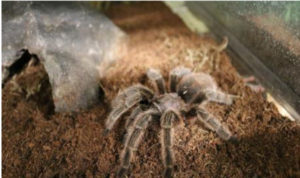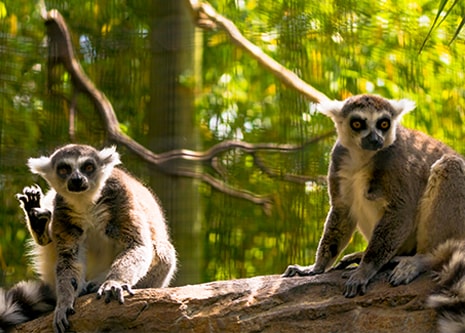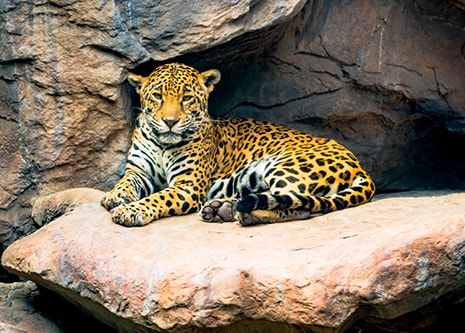
- VisitSupport Happy HollowDONATE TODAYExploreSupport Happy HollowDONATE TODAYLearnSupport Happy HollowDONATE TODAYSupport
-
Today's Hours: 10:00 am to 4:00 pm
Education AmbassadorsChilean Rose-haired Tarantula

Scientific name: : Grammostola rosea
Family: Theraphosidae
Order: Araneae
Class: Arachnida
Range: Chile
Habitat: Dry scrublands and deserts
Lifespan: Males up to 5 years; females up to 20 yearsWhat do they look like?
Spiders may look like creepy crawly bugs, but they’re not actually insects at all! Tarantulas are arachnids, a class containing tarantulas, true spiders, scorpions, ticks, and mites. Like all arachnids, Chilean Rose-haired tarantulas have an exoskeleton, two main body parts, eight
multi-jointed legs, two pedipalps (food-handling appendages), and two chelicerae (mouth parts). These tarantulas have brown and pinkish coloration on their bodies, hence the ‘rosehaired’ name. There are eight light-sensitive eyes located on the top surface of the cephalothorax that sense light. Females are noticeably larger than males, reaching a leg spanof up to 6 inches. This is a slow-growing species, taking up to 10 years for them to reach adult size.How do they behave?
Chilean rose-haired tarantulas are solitary and territorial. They live in burrows and build platform webs (webs spun on the ground). Their burrows provide relatively constant temperature and humidity, as well as safety from predators. With each molt (the shedding of the exoskeleton) urticating hairs develop on the abdomen. These hairs and can be kicked off by the tarantula onto a predator where the hairs then embed into the other animal’s skin or eyes, causing irritation.What do they eat?
Tarantulas cannot digest solid food! They must first inject venom into their prey which liquefies the insides. After this process is complete, the tarantula then slurps out the resulting fluid. In the wild, Chilean rose-haired tarantulas eat insects, small lizards, frogs, and other spiders. At the Zoo, they are fed crickets.How are they born?
Once a male tarantula reaches maturity, he will leave his burrow to find a female. When approaching a burrow, the male will tap and vibrate his legs to lure the female out. If the female is receptive, she will allow the male to mate with her. If she is not receptive, she will see him as a food source. Even after breeding, if the male does not leave quickly enough, he may be in danger of the same fate. After mating, the female will lay up to 1000 eggs, which will hatch roughly 1-2 months later.What should you know about them?
Tarantulas don’t breathe the same way we do. They have lungs called book lungs. Instead of inhaling and exhaling, oxygen transfer is passive, occurring when air flows over the book lung. This process causes tarantulas to lose water through evaporation, which may lead to dehydration without proper humidity levels in their environment.Conservation
The Chilean rose-haired tarantula’s conservation status has not been evaluated by the International Union for Conservation of Nature (IUCN). Due to their popularity as pets, there is wide-spread collection of this species from the wild for the pet trade, which may cause it to become threatened or endangered in the future. If you are considering a tarantula as a pet, make sure to research the species, be able to provide adequate husbandry needs, and acquire one from a reputable captive bred source.
Zoo on the Hill
Located across from the Keep-Around Carousel is the Zoo on the Hill. Learn about wildlife up close during daily meet-and-greets, leap like a lemur on the playground, brush and feed the goats,, or take a peek inside Doc’s Critter Care building and the Ranch House. Double-H Ranch features a combination of animal exhibits, including giant anteaters and red ruffed lemurs, as well chickens and domesticated animals that are docile enough to touch.
See Animals
Zoo in the Hollow
Follow the crooked bamboo pathway down into the hollow and visit with some of the most amazing animals in the world. Where else in San José can you get up close to a stunning jaguar, lemur, meerkat or American alligator? Happy Hollow is dedicated to helping save species and preserve wildlife for future generations by participating in Species Survival Plan programs through the Association of Zoos and Aquariums.
See AnimalsVisit Us Today
Plan an unforgettable experience at San Jose’s family-friendly park and zoo.
more info